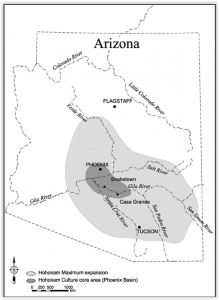
http://phoenixspatialhistory.asu.edu/canalII
The Huhugam Archaeological Culture. “Hohokam” is a term first used in Frank Russell’s 1908 report that employed a now-obsolete orthography to record Akimel O’odham (Pima) words. Along with other archaeologists, not to mention Pima and Tohono O’odham authors, we use the spelling “Huhugam,” using the 1970 Alvarez and Hale orthography preferred by the Four Southern Tribes.
The Huhugam culture is well known for its sophisticated social organization, its sustainable adaptations to the desert, its fine crafts, and for the extraordinary intensity of archaeological investigation devoted to it. The area now covered by metropolitan Phoenix, sustained a Huhugam population of 30,000 to 40,000, the densest and longest-lived occupation in the prehistoric Southwest. As sedentary, desert farmers, the Huhugam developed the largest and most complex irrigation works in ancient North America, with canals up to 30 km in length.
With the reorganization following the ballcourt system’s collapse ca. AD 1070, the occupied area contracted and population density rose. “Classic” period settlements focused on rectangular platform mounds upon which elite houses were sometimes established. Most Huhugam towns were abandoned by the mid-1400s and the population dispersed. We recognize both Huhugam and post-abandonment sites as ancestral to modern Akimel O’Odham (Pima) and Tohono O’Odham (Papago) peoples.Early Huhugam agricultural settlements of surprising size and complexity date back to 1500 BC. By AD 450, the Huhugam had large, canal-focused, sedentary communities, many of which were continuously inhabited for a millennium. By AD 1000, more than 80,000 km2 (Figure 1) were integrated in a network focused on Mesoamerica-inspired, ceremonial ballcourts. Ceramic compositional studies show that enormous volumes of specialist-produced red-on-buff decorated ceramics, as well as utilitarian pottery, were distributed through periodic marketplaces focused on these ballcourts (Abbott 2009; Abbott et al. 2006). The ballcourts likely also served as venues for trade in agricultural products, wild resources, and diverse craft goods including elaborately woven cotton, clay figurines, fine chipped and ground stone implements, marine shell bracelets and other ornaments, and even copper bells from West Mexico.

http://phoenixspatialhistory.asu.edu/canalII
Archaeological Work on the Huhugam. In the 1880s, Phoenix Basin Huhugam sites were the focus of one of the earliest problem-oriented, multidisciplinary investigations in the US, the Hemenway Southwestern Archaeological Expedition (Haury 1945; Hinsley and Wilcox 2002). The 1930s and 1960s excavations at Snaketown in the Gila River valley south of Phoenix defined the Hohokam “culture” (Gladwin et al. 1937, Haury 1976). Although Snaketown, Casa Grande Ruins (now a National Monument), and Pueblo Grande are the best known Huhugam sites, thousands of Huhugam sites dating over 3000+ years are spread across central and southern Arizona. The two largest Huhugam population concentrations lie underneath the Phoenix and Tucson metropolitan areas.
Urban development driven by the population explosion in these two areas, coupled with the requirements of historic preservation legislation, have resulted in an extraordinarily intensive investigation of the Huhugam—most using modern excavation methods. The overwhelming majority of the documents to be included in DAHA are detailed, descriptive reports. These reports range in size from perhaps 75 pages for a small project to more than 7,000 pages in the case of a large, multi-year project. We estimate the corpus to be on the order of 1,600 major reports with 400,000 pages.
Reports typically include a background chapter on relevant earlier work; they describe and illustrate (with photographs and drawings) architectural contexts and the individual features investigated (e.g. agave roasting pits or canal exposures); and they have chapters summarizing project dating samples and the analyses of different classes of material remains (ceramics, ground stone, animal bone, shell, etc.), frequently including comparisons to other sites. The reports often summarize the relevance of project results to current research questions, though how successfully that is done varies widely.
The most important challenge facing Huhugam archaeology is not a lack of data; rather it is an inability to synthesize and preserve the enormous volume of information accumulated over the last 130 years. Huhugam archaeology is thus an ideal exemplar of the central problem of synthesis.

